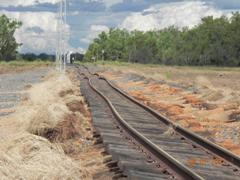21 February 2012
 Adelaide’s climate will become hotter and drier to mirror Whyalla’s climate in 50 years’ time – and we need to prepare for this change accordingly, research conducted at UniSA has found.
Adelaide’s climate will become hotter and drier to mirror Whyalla’s climate in 50 years’ time – and we need to prepare for this change accordingly, research conducted at UniSA has found.
In a report released today on the National Climate Change Adaptation Research Facility (NCCARF)website, UniSA researchers have looked at how Adelaide can learn from experiences in both Whyalla and Port Pirie, two regional cities already experiencing the predicted climate change for Adelaide in the next half century.
Lead researcher Associate Professor Jon Kellett, from the Barbara Hardy Institute, says insulating homes and water-proofing gardens are very sensible precautions to take now.
Assoc Prof Kellett says while people shouldn’t be unduly concerned, we should recognise that certain things will change and we should seek to adjust behaviour.
“In March 2008, Adelaide had a 15-day heatwave of temperatures over 35 degrees,” he says.
“Whenever we have an extreme weather situation like that, we see railway lines buckle, the electricity grid can’t handle the over-use of air-conditioners, and more people are visiting GPs and emergency departments with heat-related illness.”
The researchers worked closely with the City of Whyalla and Port Pirie Regional Council, as well as Playford and Port Adelaide-Enfield councils, investigating land use and planning, infrastructure such as pipelines and railways, provisions for health, designs for housing, public open space and gardens.
Assoc Prof Kellett says a key issue for Whyalla, for example, was the die back of street trees.
“Given that we plant trees and expect them to survive for 100 years or more, we should be thinking very carefully about how the species of tree we plant today in Adelaide will cope with the climate in 80 or 100 years’ from now,” he says.
“The question of species selection is also relevant to bushfire threat. We should be looking to plant native species that can recover from bushfires in the medium term.”
Assoc Prof Kellett says the experience of more northerly settlements in SA with sport ovals ‘browning off’ in drought had a negative impact on communities.
“Sports ovals in particular are often the heart of the community,” he says.
“So initiatives like Adelaide’s use of recycled water on the parklands are a good idea and demonstrate that Adelaide is switched on to the issues already being faced in greater extremes by northern neighbours.”
The national project, ‘Learning from regional analogues’, paired three Australian cities with regional centres already experiencing the predicted climate change for those cities.
While Adelaide was paired with Whyalla and Port Pirie, Brisbane was matched with Gladstone in Queensland, and Bunbury in the south-west of Western Australia was matched with the more northerly Geraldton.
The full report can be viewed at www.nccarf.edu.au
Contact for interview
- Jon Kellett office (08) 8302 1701
Media contact
- Kelly Stone office (08) 8302 0963 mobile 0417 861 832 email kelly.stone@unisa.edu.au




